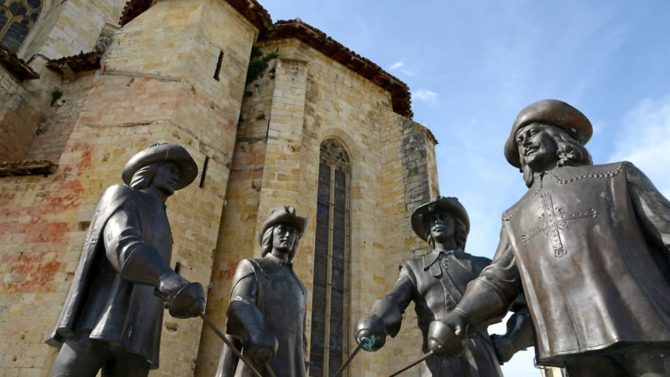French Icons: The Three Musketeers

Discover the history behind Alexander Dumas’s tale of derring-do, the ultimate swashbuckling adventure.

‘All for one and one for all’ is the celebrated motto of the Three Musketeers, heroes of one of the world’s most famous adventure novels. Translated into more than 100 languages, adapted for dozens of films and the subject of countless TV series, the exploits of three swashbuckling musketeers were the work of Alexandre Dumas, who also wrote The Count of Monte Cristo.
The exotic tale of derring-do was based on a partly fictionalised work of 1700 called Mémoires de d’Artagnan, by the Spaniard Gatien de Courtilz de Sandras, but many scenes were inspired by Dumas’s own family.
The author, whose real surname was Davy de la Pailleterie, adopted the name of his grandmother, a former Haitian slave. His father, General Thomas-Alexandre, was the highest-ranking officer of African descent in a European army and his exploits during the French Revolutionary Wars are reflected in Dumas’ novels.

Bringing the Story to Life
Les Trois Mousquetaires was first published in serial form in the newspaper Le Siècle from March to July 1844. The tale is set in the early 17th century and follows the adventures of d’Artagnan, a young Gascon who travels to Paris to become a soldier in the service of the king. He becomes friends with the three musketeers: Athos, who was once married to the wicked Milady de Winter; Aramis, who was destined to become a priest until he killed an officer in a duel, and the worldly Porthos, who plays on his good looks and ends up marrying for money.
Further Success
The novel enjoyed such enormous success that Dumas adapted it for the theatre and (co)-wrote two sequels: Twenty Years After and the three-part The Vicomte of Bragelonne: Ten Years Later, which includes The Man in the Iron Mask. One reason for the work’s early popularity was the contemporary political undertones. Dumas uses the plot to highlight the abuses of the ancien regime before the Revolution. The issue was topical because France was still divided between republicans and royalists, and France was ruled by a constitutional monarch until the 1848 revolution.
On the big screen, notable versions of The Three Musketeers include a 1921 Hollywood silent, with Douglas Fairbanks as d’Artagnan, a 1948 MGM romp starring Gene Kelly and Richard Lester’s two-part 1970s epic with Charlton Heston as a scheming Richelieu. More recently, the musketeers featured in a BBC TV drama that ran for three series.
Richard Lester’s 1970s screen version of The Three Musketeers was originally written with the Beatles in mind, but the Fab Four turned it down.
Scandals
Although Dumas is always credited as sole author of his novels, he actually had a ghost writer, Auguste Jules Maquet, who is the subject of a 2010 film, L’Autre Dumas, starring Gérard Depardieu. Maquet’s job was to research the historical backgrounds and construct plots, while Dumas breathed life into the tales, creating colourful and psychologically convincing characters, and writing scenes packed with romance and intrigue.
Maquet received a fee, but, as Dumas grew increasingly famous, he wanted to be recognised as co-writer, too. Despite taking Dumas to court three times, he was only recognised much later for his contribution. Maquet’s tombstone in Père Lachaise cemetery is engraved with the names of his three most famous collaborations: The Three Musketeers, The Count of Monte Cristo and La Reine Margot.
Like many of his characters, Dumas was a womaniser, who had more than 40 affairs and fathered at least three children out of wedlock. His last affair was with Adah Isaacs Menken, an American actress notorious for a role where she rode a horse naked on stage. The relationship caused a scandal as Dumas was more than twice Menken’s age.
Dumas died in 1870, aged 68, and was buried in his birthplace of Villers-Cotterêts in the Aisne département. In 2002, to celebrate the bicentennial of the author’s birth, President Jacques Chirac had Dumas’s ashes re-interred in the Panthéon mausoleum in Paris, where he now rests near his rival Victor Hugo.
“Alexandre Dumas will finally take his place beside Victor Hugo and Émile Zola, his brothers in literature,” said the president. “With you, it is childhood, hours of reading relished in secret, emotion, passion, adventure and panache that enter the Panthéon. With you we dreamed; with you we still dream.”
Enjoyed this? You might also like:
On the Trail of the Musketeers in Brittany
Share to: Facebook Twitter LinkedIn Email
More in french icon


